October when wet and rainy is not a month I enjoy that much in the garden , leaves everywhere and everything is past it’s best , already signalling that this year’s growth is over but it is a useful time to get started early on the clean up and putting the garden to bed for the winter months .
Of course all that pessimism is forgotten on dry days in October when the autumn leaf colour come into it’s own !

Japanese Maple , Ozakazuki , front garden , October 30th 2018
This year probably due to the drought in June and July has produced terrific leaf colour in most shrubs but particularly with the rhus cotinus or smoke tree and what really surprised me was the dying leaf colour of the climbing wisteria which rivalled even the better known autumn colour of the japanes maples and it reminded me what a great all year rounder wisteria is apart from it’s three week flowering period of pale blue which is justifiably famous but I love it’s soft olive green leaf which lasts from April to October and now how it goes into hibernation with this wonderful burst of dying leaf colour .
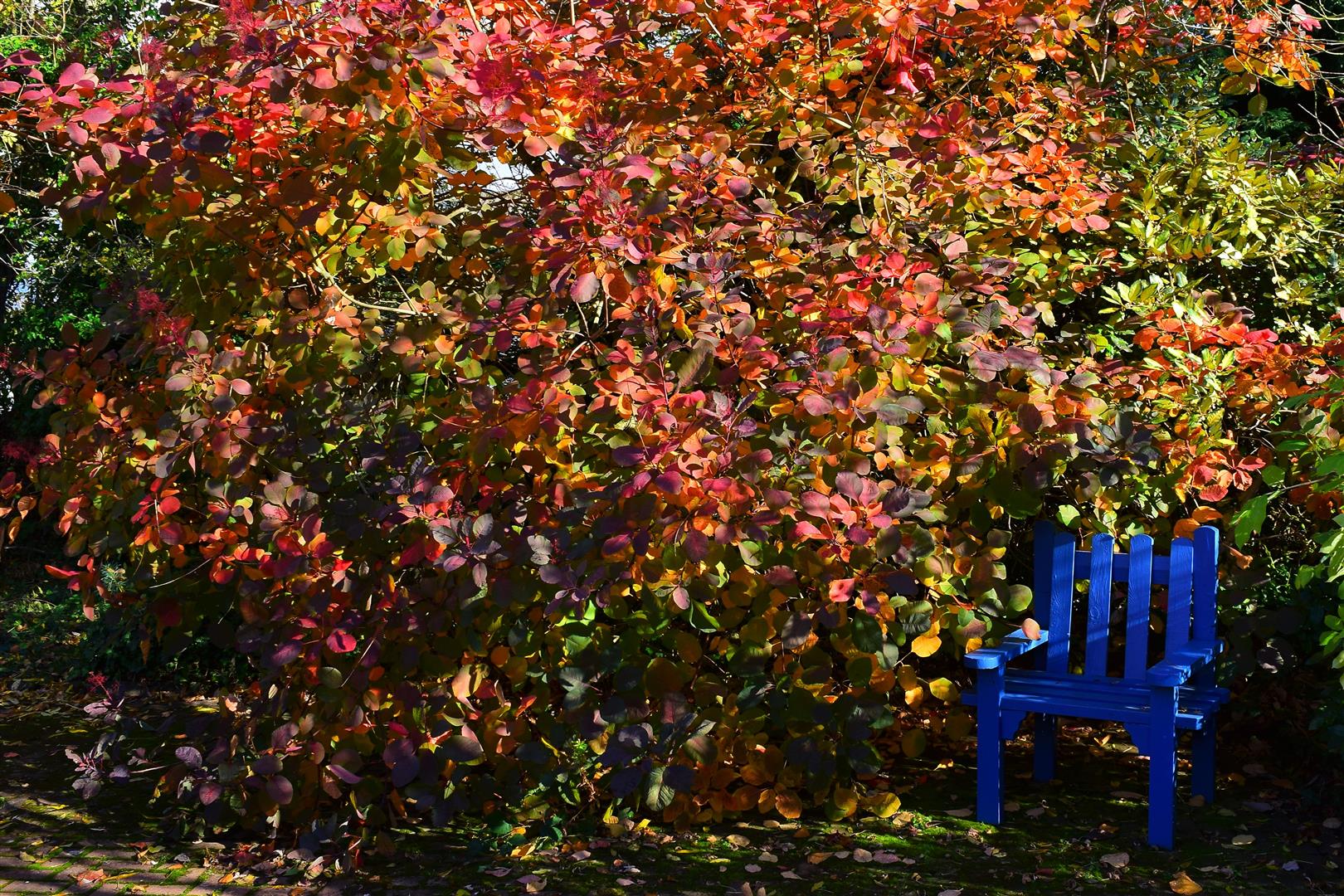
Rhus cotinus , the smoke tree , front garden , October 30th 2018
October is the best month to plant spring flowering bulbs such as tulips , daffodils and snow drops and I always plant in groups of seven bulbs in dryish soil as they just won’t come up in wet water logged soil as I know to my cost from two years ago when I planted 300 daffodil bulbs in wet ground … never saw them again . The general rule is plant a bulb four times it’s height deep and in my view you should delay planting bulbs in any garden until you have a solid outline of design as invariably you will plant them in prime areas which could be better used for trees and shrubs and then forget where you have planted them and there is nothing like the awful sound of a spade crunching through a lovely group of bulbs . I plant bulbs mainly under shrubs that lose their leaves as by the time the shrub comes into leaf in March / April the bulbs are fading and the new growth hides the now untidy looking daff / tulip leaves and they can be left to wither away hidden from sight … next year’s bulb gets its strength from letting the leaves die back naturally and if you have no option but to cut down untidy daffodil growth leave it for a minimum six weeks after flowering .
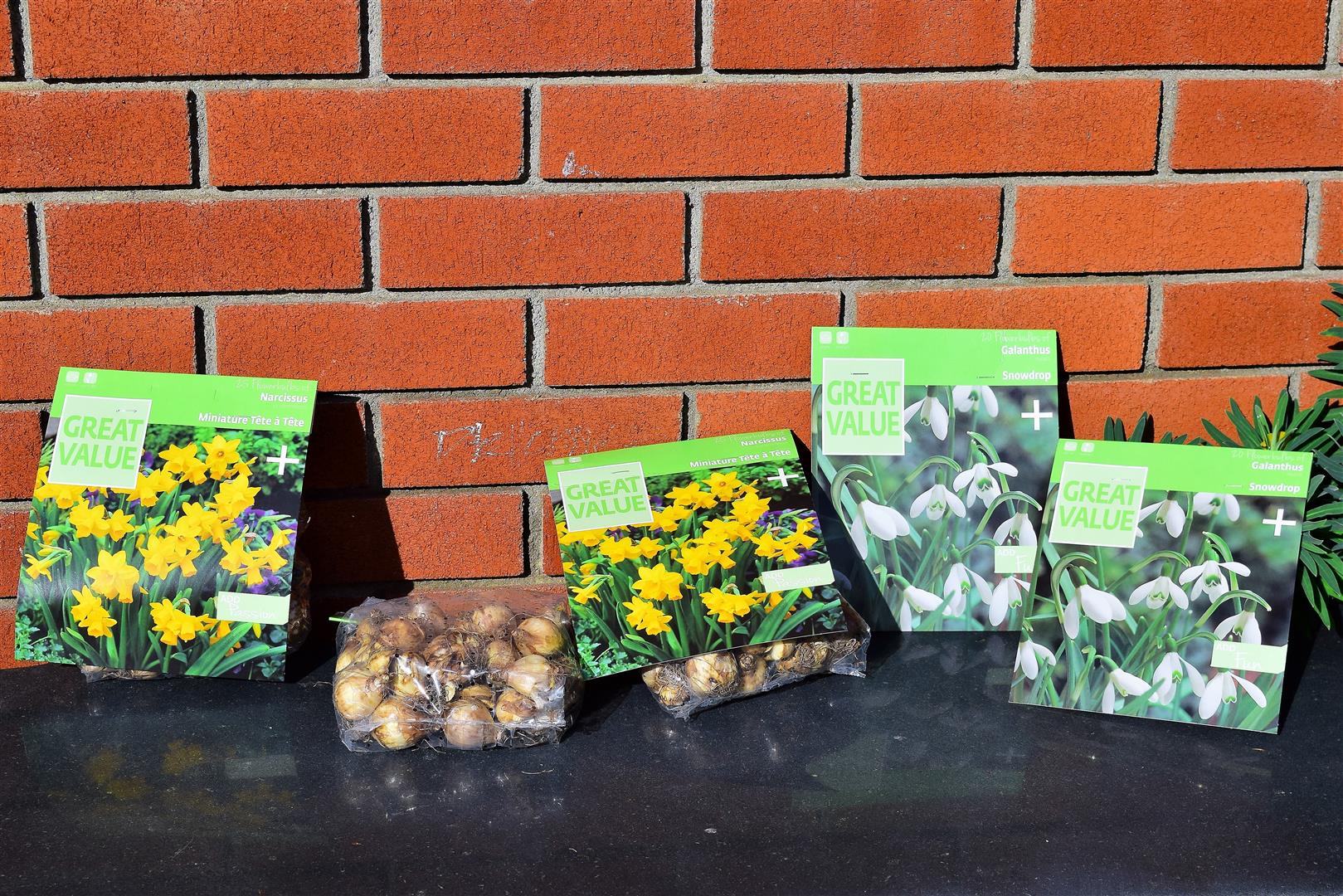
A selection of dwarf daffodils and snow drops ready for planting , October 20th 2018
I don’t bother anymore with either tall daffodils or tulips as they blow over too easily in wind and I exclusively plant dwarf varieties now with the dwarf daffodil tete a tete my favourite . As a gardener in summer you are constantly making notes as to what patch could do with some spring bulbs to brighten up those February / March months and tete a tete is super reliable for a long lasting display . Snow drops you can’t have enough of , the first bulb to flower in darkest January , undemanding and a clump increases without fuss each year and as I am not a galantophile i.e. snow drop mad , the common one is good enough for me , better if you can dig up or divide a clump after flowering a method which is called planting “ in the green ” as the commercial bulbs sold in packets at this time of year are not reliable in my experience , a bit hit and miss but I always try a few packets every year . I have given up on tulips completely as our heavy soil does not suit them and we generally don’t see them again after two or three years in the ground but a great idea if you love tulips is a tulip lasagne where you set aside a pot or two purely for tulips and then plant the bulbs in two layers with late and early flowering varieties with the later flowering bulbs in the bottom row with about four inches between layers and the bulbs can be planted directly over each other as the bottom bulb will just grow around the top one and incidentally when planting any bulb don’t be overly concerned about the bulbs falling sideways in the planting hole as you shovel over the soil as bulbs grow away quite happily even when upside down !
This October’s planting of dwarf daffodils saw an unusual collaboration between the two Head Gardeners here with me of course digging fifteen holes and Snezana planting the bulbs ever so delicately !

Planting dwarf daffodils in the lower garden for next spring , October 15th 2018
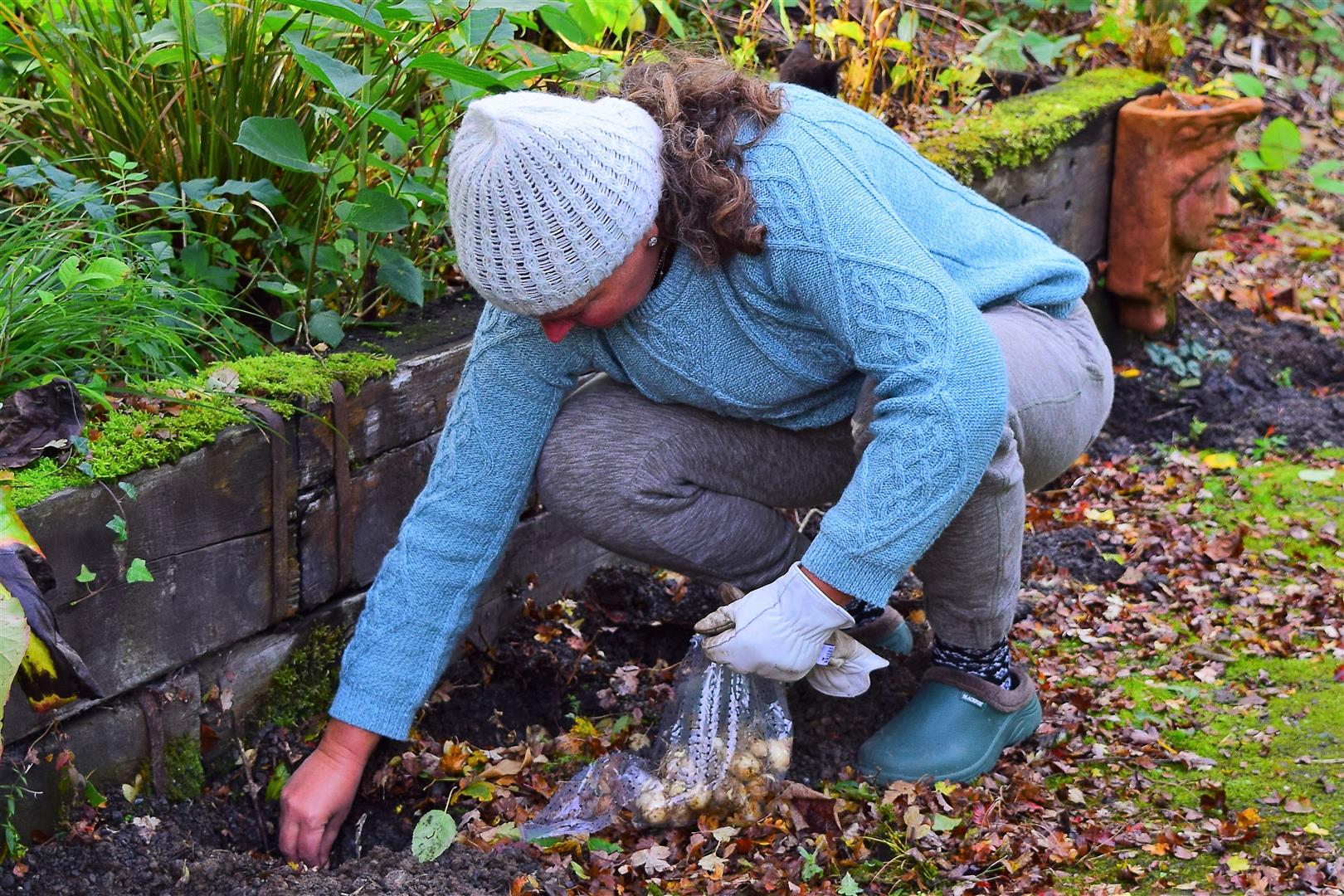
A delicate task placing the bulbs ! October 20th 2018
We spent a week in Sicily at the start of October , a place I have always wanted to visit both for it’s many 5th century BC Greek temples and theatres ( colonised from 700 BC by Greek settlers ), it’s mixture of Arab and North African food influences but also for it’s uniqueness from 1000 AD onwards in the tolerance that existed between Jewish , Norman and Islamic architecture where builders from all three faiths collaborated on the building of churches and worked side by side unlike the rest of the world at that time .

Valley of the Temples , Agrigento , Sicily , October 3rd 2018
What surprised me though when travelling across Sicily was how deserted the centre of the island is , deserted but beautiful landscapes and what really surprised me was the shanty town appearance of the hill towns , no beauty there as they all seem to have been thrown up in a hurry in one big concrete mess unlike mainland Italy where there is real beauty in the hill towns but a huge problem in Sicily is the corruption and the Mafia involvement in all aspects of daily life which has siphoned off the huge structural funds the EU have been pouring into the region with the effect that nothing or at least very little filters through to the people .

Palermo , Sicily , October 4th 2018
This a mosaic from the floor of the roman villa in Piazzo Armerina , dating from 300 AD … bikinis were reinvented eighteen hundred years later in St. Tropez !

The first bikinis , 300 AD , Piazzo Armerina , Sicily , October 4th 2018
Mount Etna , the famous volcano , it is still active , 3,500 metres high and we were able to get close to the summit by cable car which was a great experience , fabulous volcano ash soil around the mountain which is famous for it’s vines planted lower down on the slopes , great honey also as everything in the vicinity of Etna , wild flowers , vines is watered from the mountain side with rain water filtered through pure volcanic lava dust .
Beautiful soil and they can and do grow anything in Sicily and there are lemon and olive trees everywhere .

Snezana on Mount Etna , Sicily , October 7th 2018
What I had not read or heard about before our visit was that Sicily has a huge tradition in hand painted ceramics which is heavily influenced by the Moorish influence from North Africa and that Sicilians love decorating their balconies with unique ceramic pots , all hand painted and there are about five major painters whose work is highly and I was amazed at the various displays , the only place comparable that I have seen is Cordoba in Southern Spain with it’s famous private patios all highly decorated and again with a huge Moorish influence from Morocco .
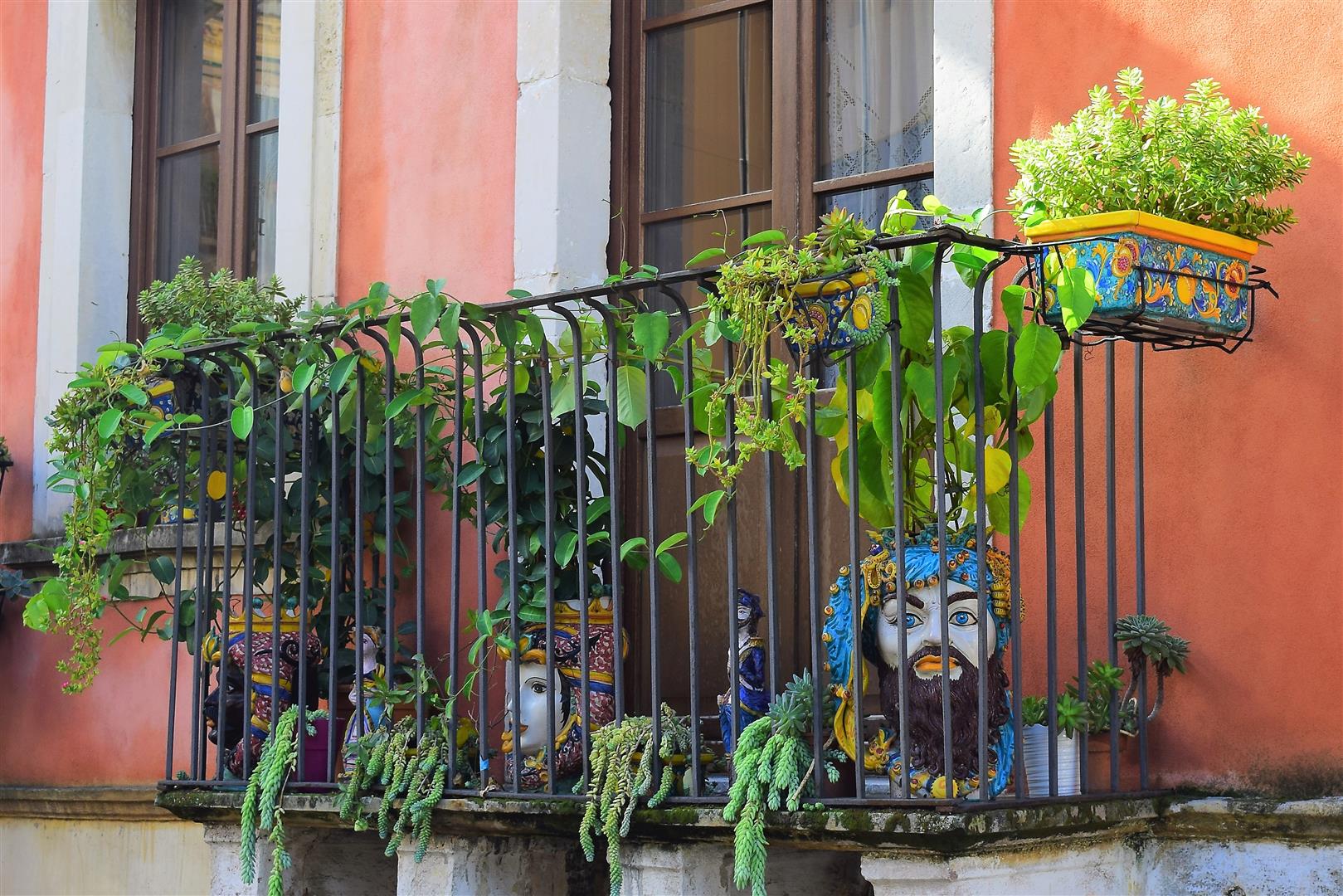
Typical balcony with North African style pots , Tauromina , Sicily , October 5th 2018
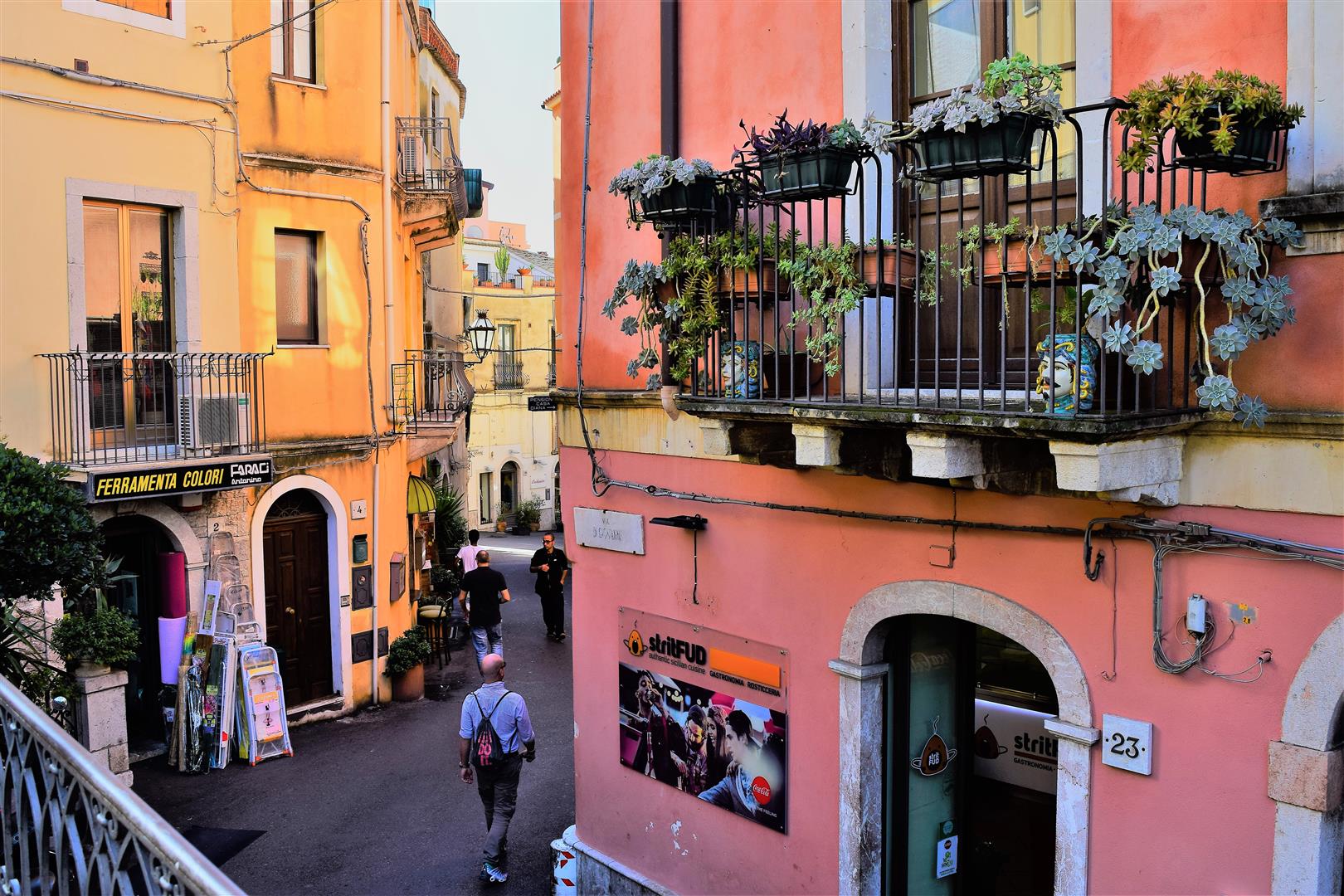
Balcony in Tauromina , Sicily , October 8th 2018
And a pot a little bit older , from 400 BC , at the Greek Theatre in Tauromina , Sicily , October 6th 2018 .

2500 year old Greek wine amphora , Greek Theatre , Tauromina, Sicily , October 6th 2018
The Islamic influence in Sicilian architecture could be straight from the Alhambra Palace in Granada with it’s water fountains as at Monrealle Cathedral outside Palermo .
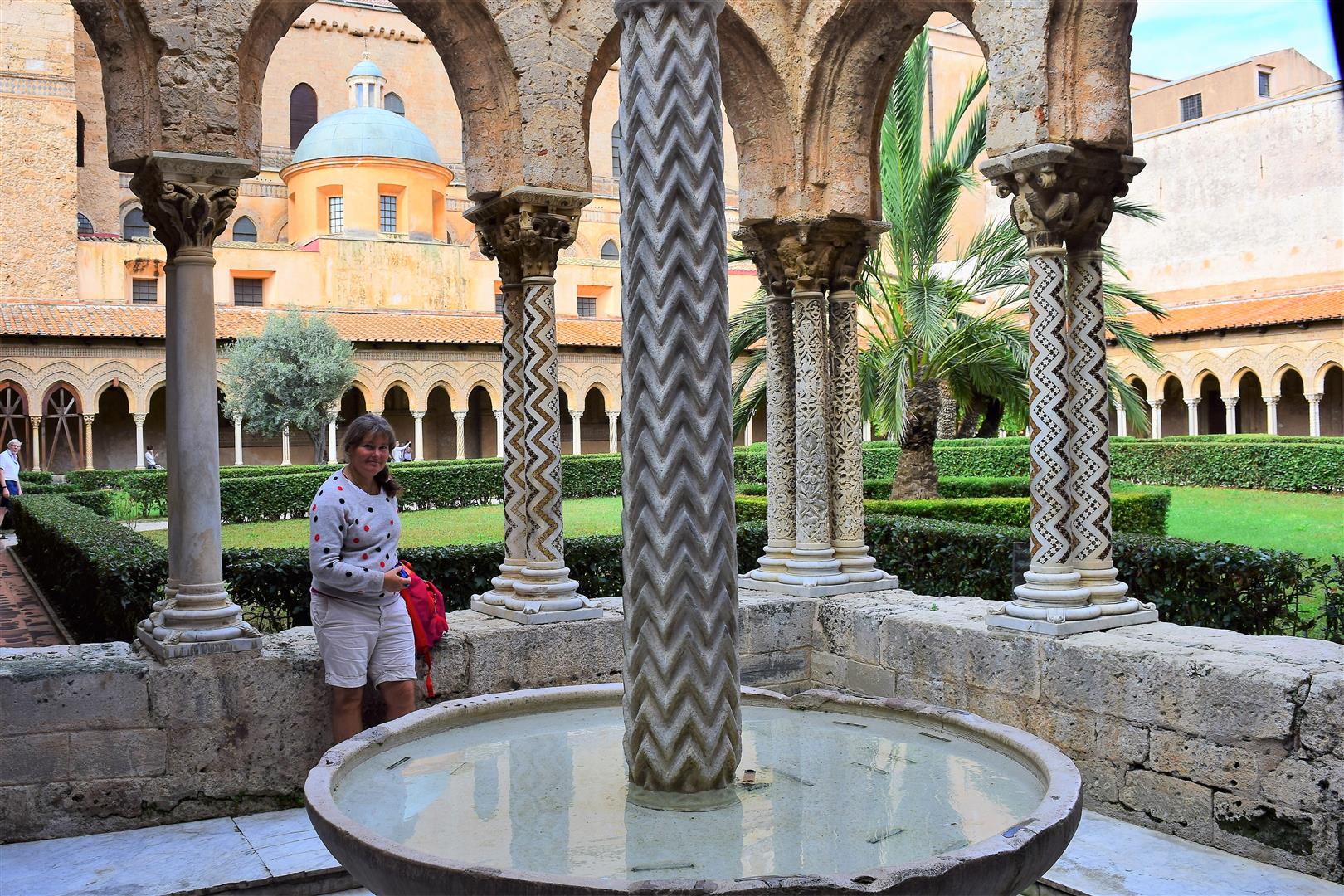
The Cloisters outside Monrealle Cathedral , Palermo , Sicily , October 4th 2018
Of course Sicily is famous for the Mafia and when in Tauromina we took the Godfather Film tour which took us to the villages Savoca and Forza D‘Agro . where a lot of the scenes in the Godfather films were shot including the church where Michael Corleone was married in , nothing much has changed physically in these villages since the filming took place in 1971 and they make a little money from the trickle of movie fans that still visit through having a drink in Bar Vitelli where Michael first saw Appolonia and selling a few T shirts with Al Pacino’s face , the villages are still authentic and atmospheric with no trinket shops or hard sell and a real pleasure to visit .

The church in Forza D’Agro , featured in the Godfather film 1972 , October 5th 2018

Two gardeners in Savoca by the Statue to Francis Ford Coppola who directed the Godfather , October 5th 2018

The famous Bar Vitelli , Savoca , Sicily from the Godfather , October 5th 2018
I take all the photos in the garden used in the blog myself as photography has been a hobby for over forty years but have always loved seeing another photographer’s take on the garden and this week John Kelly came around on a private visit , John , a professional freelance photographer whose work with the Clonmel Nationalist is well known and his most recent assignment a few days ago was with the Irish Times . John focussed on close up of the autumnal dying leaves and I particularly like this shot of a judas tree , cercis , leaf .
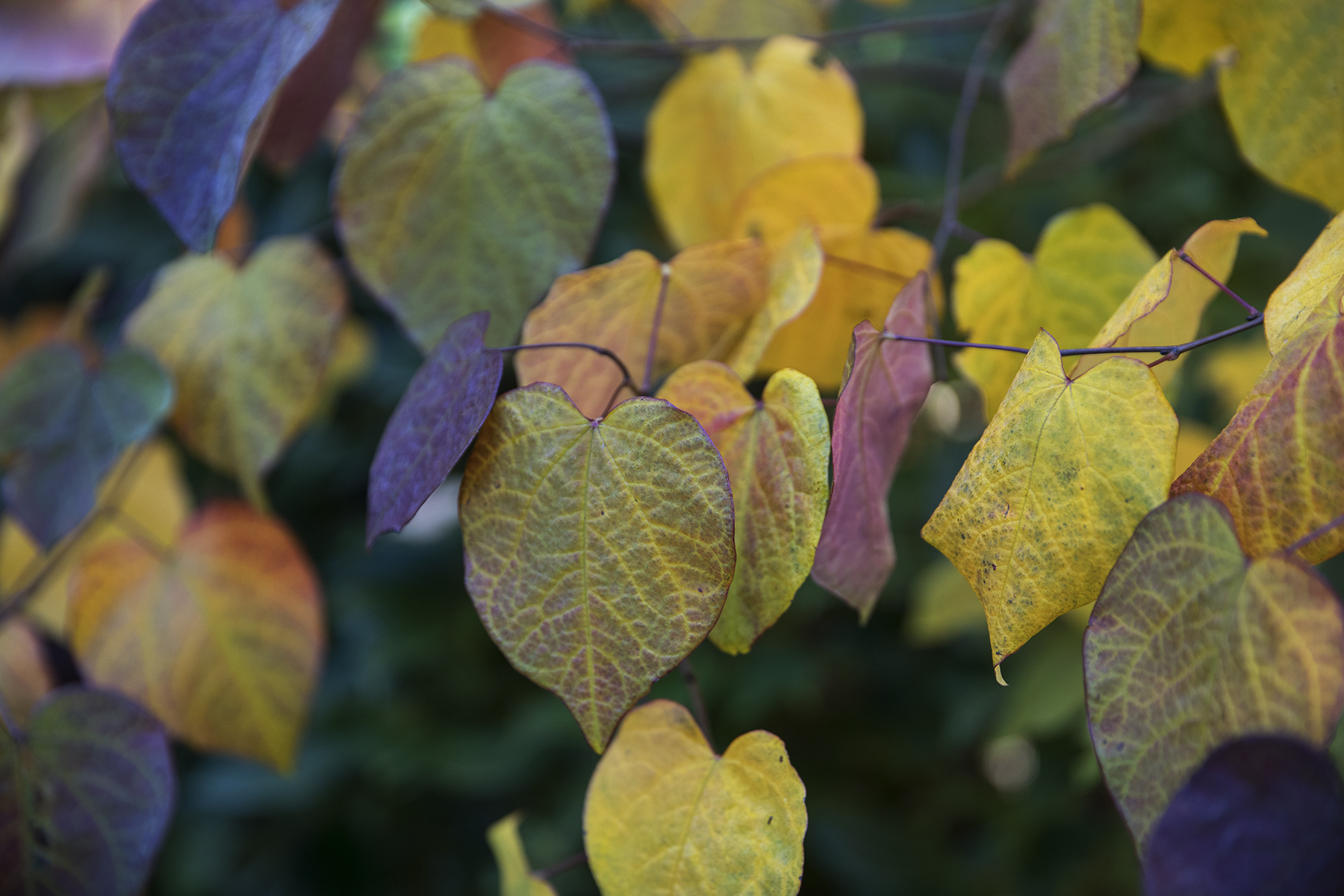
A cercis leaf backlit by John Kelly , front garden , October 20th 2018
I have wanted a video of the garden for some years now that it has reached a certain level of maturity but having done quite a bit of video work myself mainly when the kids were young I know what I don’t want in a video and that is amateurish I Phone footage and a lot of me me footage commentary so it needs to be well edited and produced and WHAT I also want is drone footage of the garden which is something I have no experience of and which will give an unusual perspective of the garden . John brought Michael Trehy , a professional videographer to do a trial run or flyover with a state of the art drone system and this produced almost an hour of footage which we will repeat again in Spring just before the leaves come back on the trees with final filming next June / July when growth is at it’s most luxuriant .
The trial run was useful for both of us as I had not realised what an amount of leaf cover there is here so a lot of the first run footage is quite repetitive and you only see glimpses of the garden below so the height that the drone operates at will need to be set much lower and while the drone does give a unique view it will be a hand held video camera that will make up the bulk of the film . Another important point was that Michael did not know the garden as this was his first visit or where the paths were which is hugely vital when flying the drone so a lot more ground work is needed .
The first results were in 4 K and were visually stunning while less stunning was my speaking in close up to camera so apart from a brief introduction at the beginning and an equally brief summing up most commentary will be off screen … interestingly when the drone first flew and hovered at 100 metres height the nesting crows came up in small groups to have a look at this strange invader of their air space but after a close look in mid air decided it was not a threat and flew away !
I plan to edit and script a fifteen minute film of the garden sometime next summer and will put it on YouTube and on the garden website so watch this space for news of my Cecil B de Petrovska effort !
We had what I imagine will be our last gardening club tour of the garden this week when the Kingston College group from Mitchelstown visited and who were last here in October 2015 , a group of people who mostly spent their careers with the British Government in what is now Zimbabwe and who all had interesting stories of how it was in what used to be Southern Rhodesia and how the Mugabe government when it took power made it clear there was no place for the white colonials.
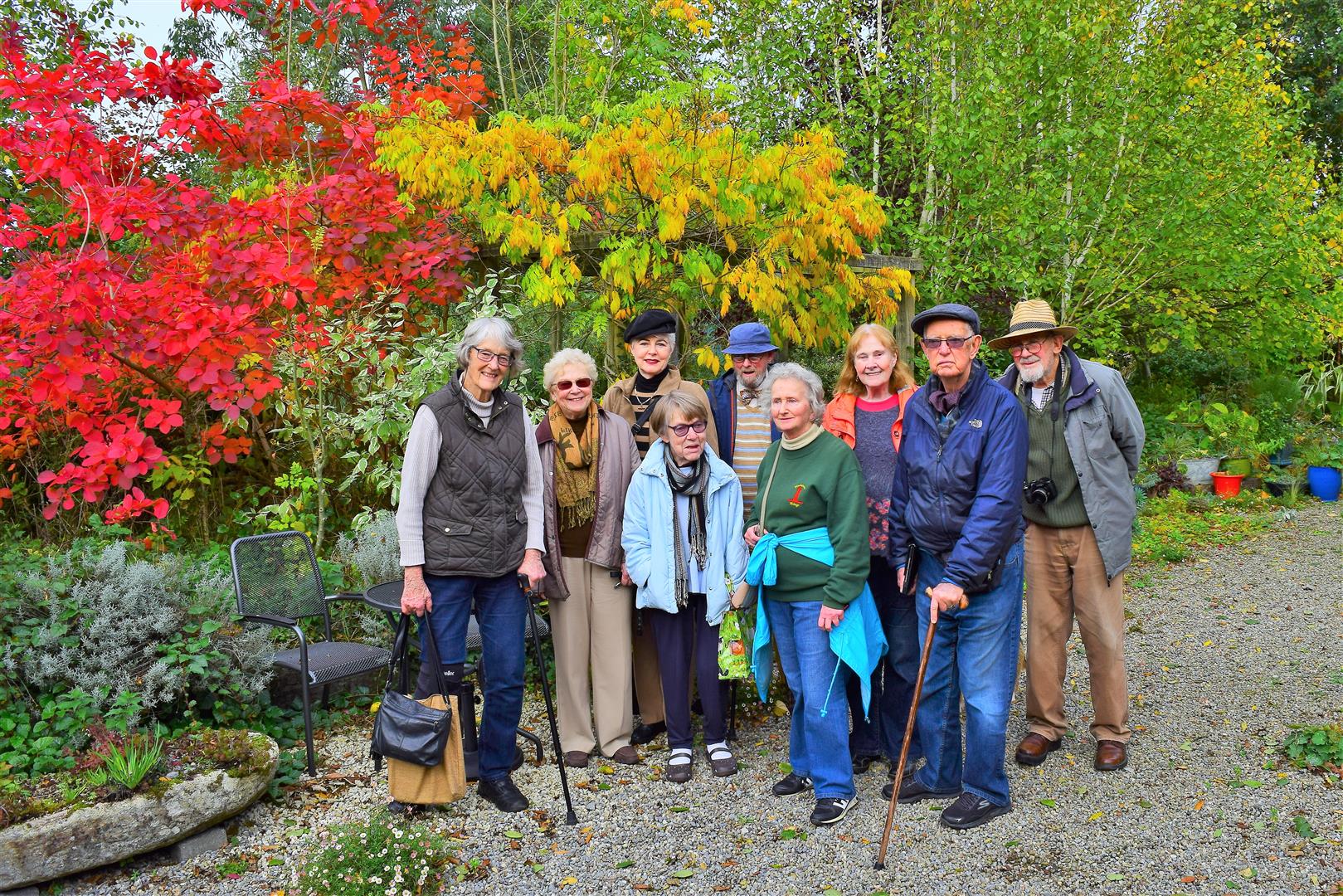
Kingston College Garden Group visit October 20th 2018
A recent visitor who has a large amount of trees to plant on a new site asked me what is the secret for planting trees and to be honest it is just common sense in that don’t plant in water logged soil and basically any tree should grow but of course there are certain steps that will help enormously , the planting hole should be large and adding a spoon or two of a slow release fertiliser such as osmacote around the roots will help the tree through the first six months in the ground as well as a short stake to stop root rock and after that keep an eye on it for signs of drought in the first year and if after a year there is no real growth dig it up and plant somewhere else and I have found that moving a tree even a metre can inexplicably help … the latest trend is to dig a round planting hole as this is supposed to help the roots get into the soil quickly but I never do this and round or square I feel makes no difference .
Nowadays you can google the name of the tree and in seconds you will be given an outline of what likes and dislikes each tree has but for me even today my source has always been Christopher Llyod’s book the Well Tempered Gardener which I first read in 1976 with my first garden as Llyod ‘s advice was always direct no nonsense and he wrote from a lifetime’s experience with plants and if he said a particular tree or shrub was difficult to grow , well you better believe it and steer clear but by and large there is no mystique about success in the garden … right plant right place and if it grows it grows and if not move it to another location .
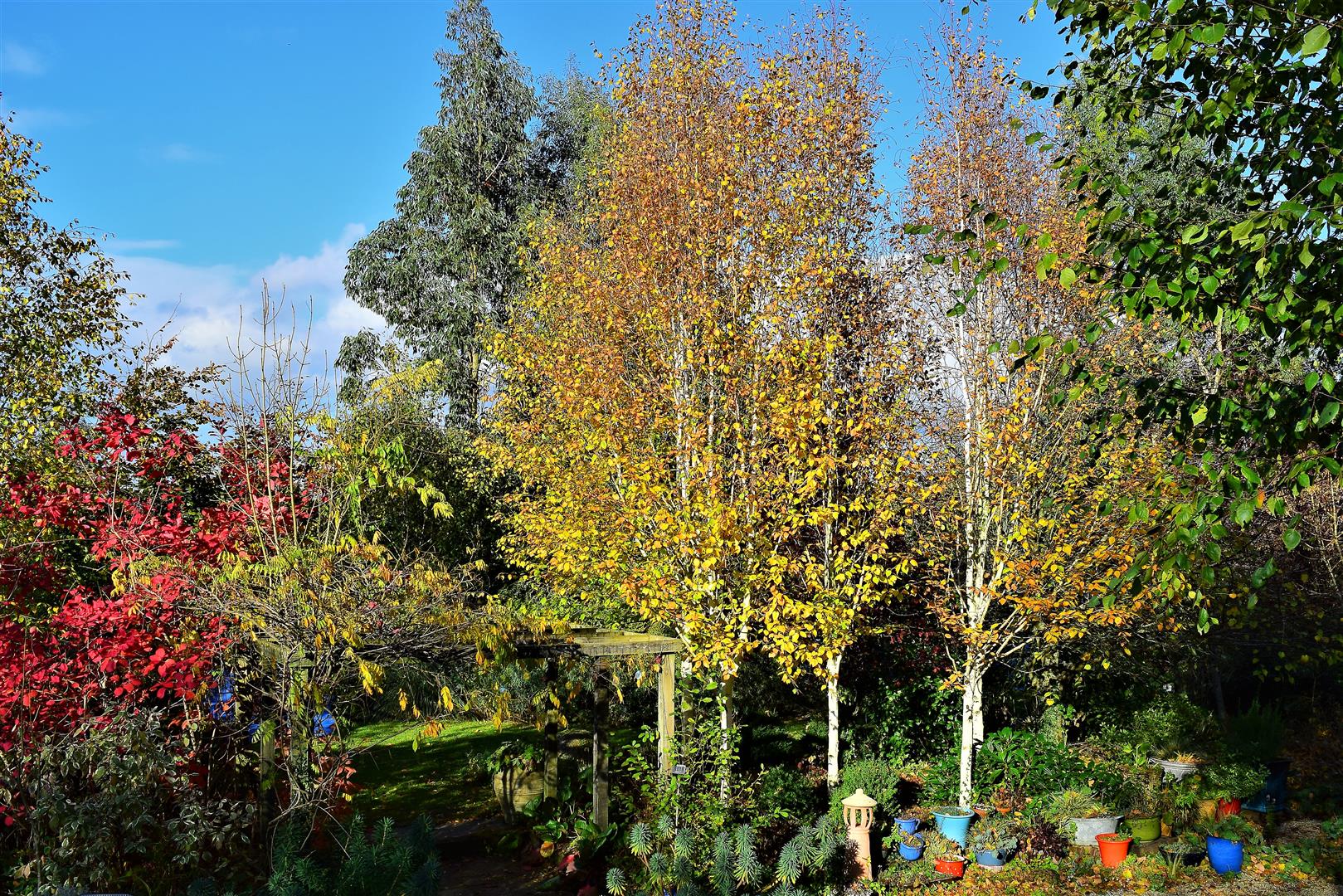
Silver birch in the back garden , October 28th 2018
The Silk Road that took traders all the way from China to Venice in the 12th century opened trade routes across the known world and allowed goods previously unknown such as silk and spices to reach Europe but it was a two way road and goods such as war horses reached China along the road and in time trees and shrubs from the East such as hostas and acers made the journey to colonize our gardens here . We have walked part of the road in Anatolia and Jordan and some day hope to make it to China but as modern day gardeners we have our own version of the Silk Road and plants pass from gardens to gardens through divisions and cuttings and today I took delivery of a group of darmera and that lovely geranium nodusum from a friend who was splitting some overgrown crumps , both plants are never for sale in garden centres as they have fallen out of fashion as darmera in particular is too big for modern small gardens while rozanne is the geranium most commonly sold nowadays and while handing over the treasure throve my friend mentioned that a friend of hers was looking for some gunnera plants which have also become rare in the garden centres so next week I will split and pot up some gunnera clumps here to be delivered in the spring so our little version of the silk road is flourishing !

Snezana on the Silk Road in Cappadocia , Turkey , May 11th 2011
And while on the subject of gunneras they are along with hostas my absolute favourite perennials and the end of October also sees the end of both for this year with the big gunnera leaves getting a real blackening from the first frosts this last week . Gunneras die badly and look a terrible mess but here I cut back and fold the leaves in on each other to form a package that will stay as cover against frost damaging the emerging new growth next spring and this also tidies up the mess of leaves and adds a bit of structure to the gaping hole left in the garden wherever the gunneras are a feature … and boy are they a feature in any garden with the space to take their gigantic stature and in their pomp in late May until end of September they dominate the garden .
Three stages of gunnera in the garden , in full glory early May , first frost late October and clean up .
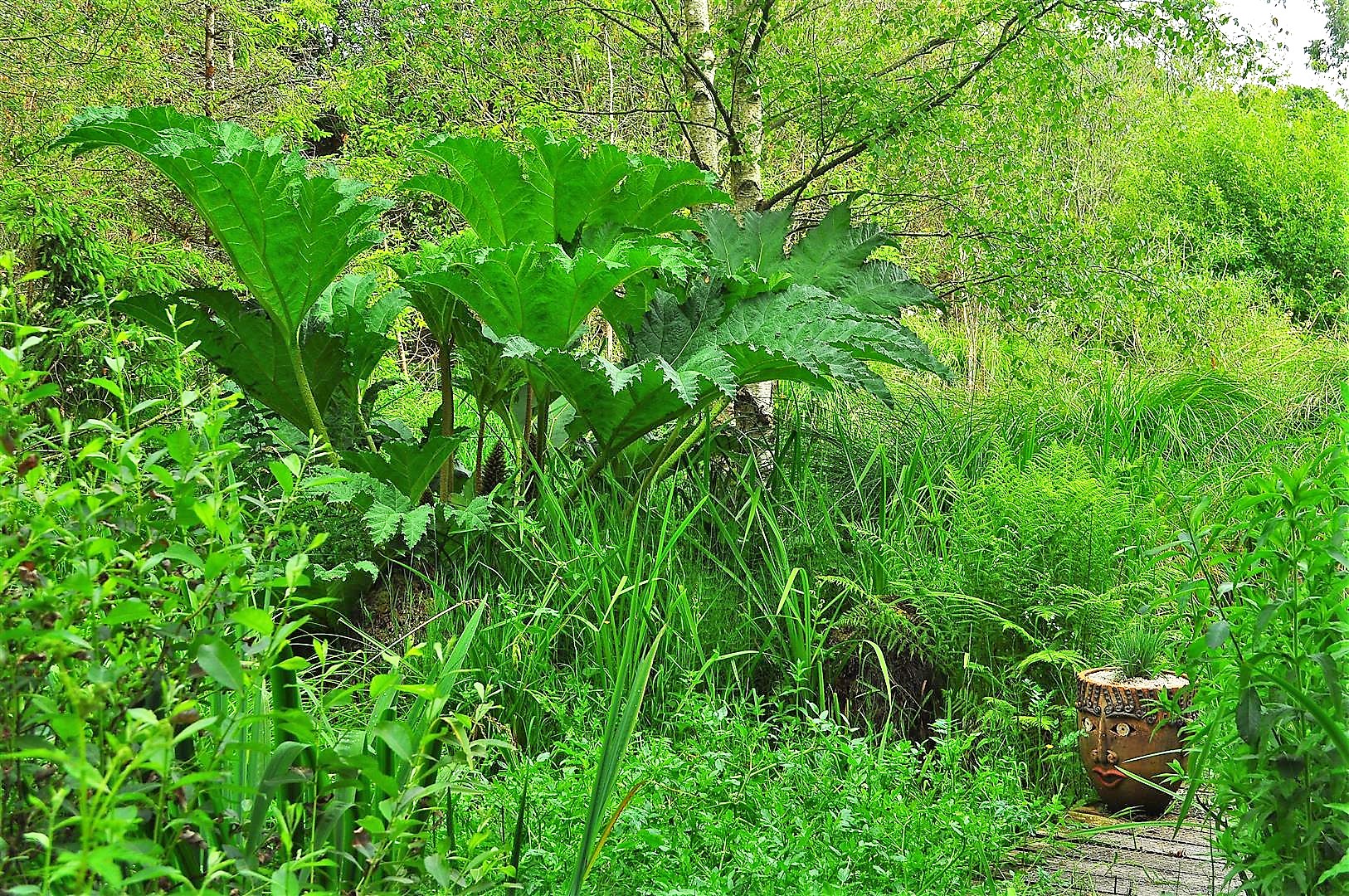
Gunnera in the water garden , May 2018
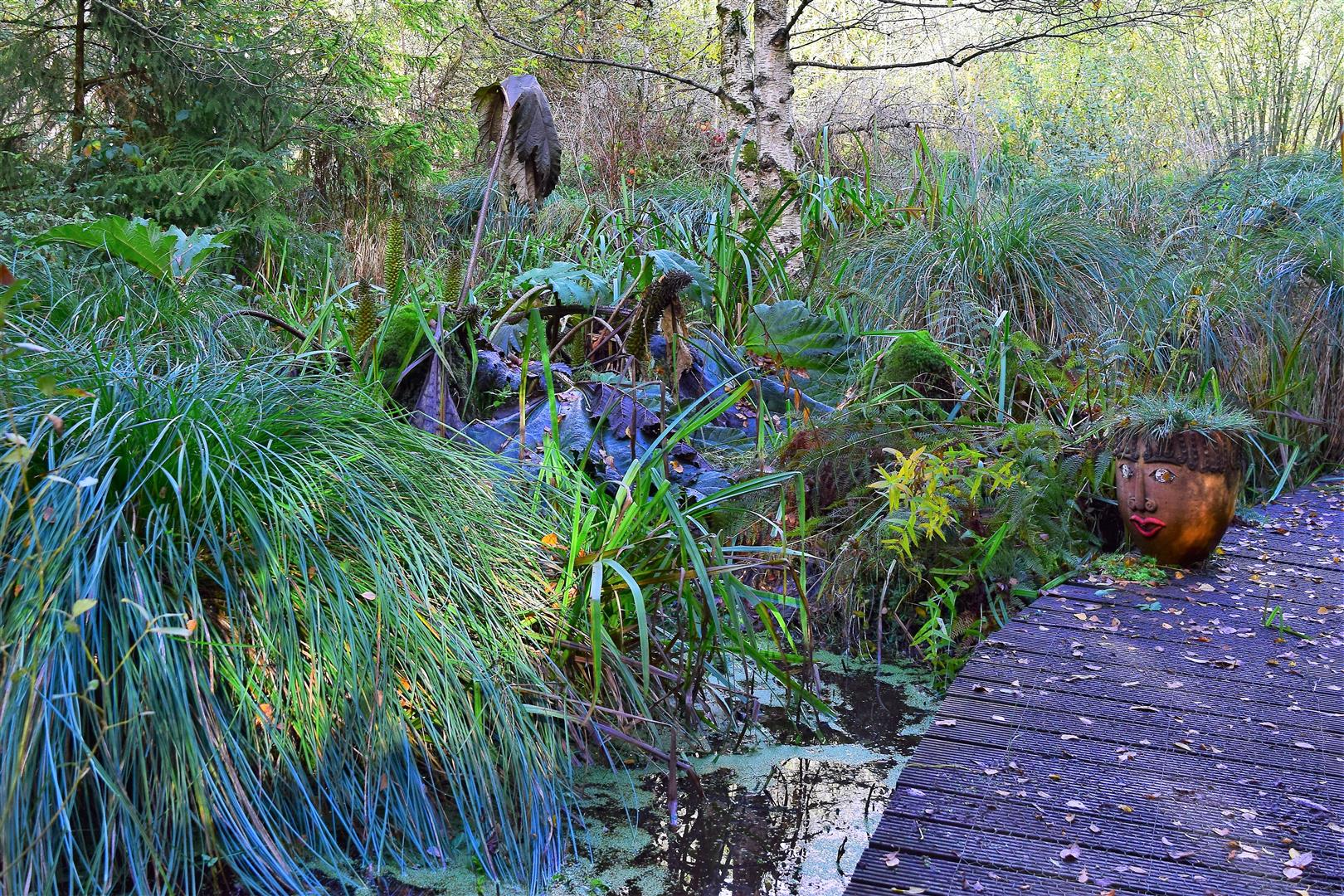
The first frost in the water garden , October 31st 2018
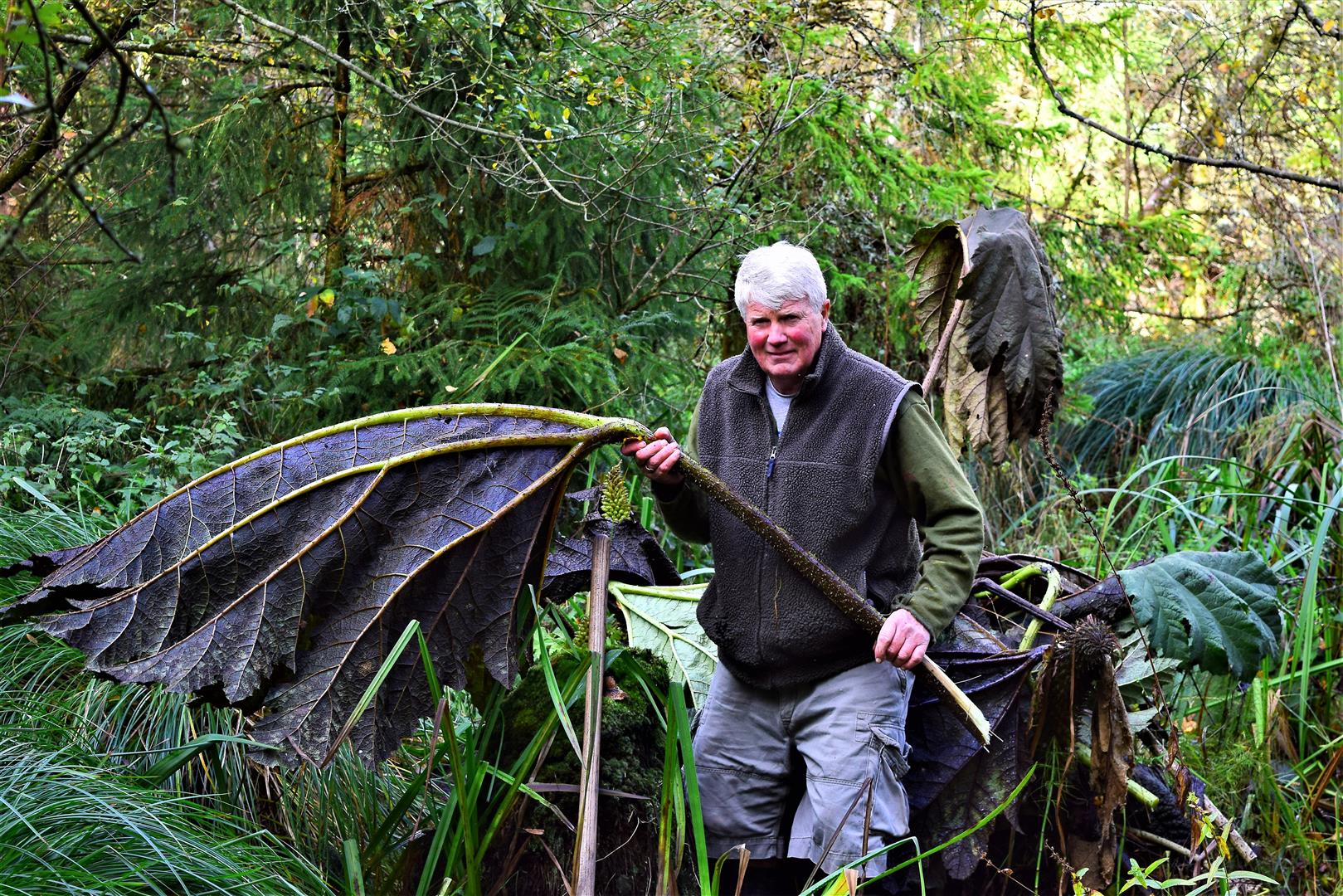
Gunnera being put to bed for the winter , October 31st 2018
And that dear readers is the three stages of gardening !


Leave a Reply